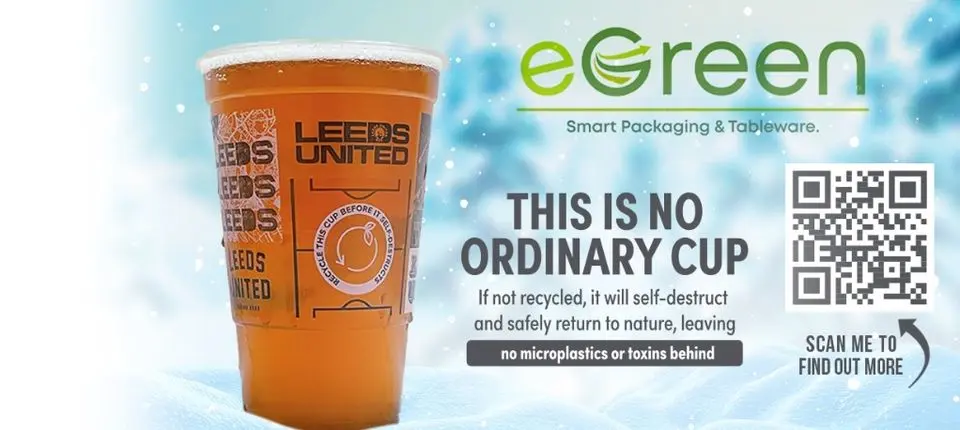Leeds United are pleased to announce that we will be introducing a new ‘Self-Destruct Cup’ pint cup to Elland Road for this weekend’s fixture against Huddersfield Town.
The ‘TWOinOne Flexy-Glass’ is produced by eGreen and made with technology from polymateria, which is verified by British standards BSI PAS 9017:2020, the standard for biodegration.
The cups self-destruct in less than two years, with the right conditions; light, warmth, moisture and air.
Leeds United are implementing the self-destruct cups as they are greener than paper, using 17% less energy, 42% less water and 22% less petroleum. Having these destructible and reusable cups in the business will reduce our carbon footprint as we will have less reliability on plastic.
Also, having listened to fan feedback, we want to provide a sturdier cup as we have found that when serving drinks in paper cups, they can become soggy.
Statistics show that 32% of plastic escapes collection systems and ends up in nature. By using self-destructing cups, we are reducing the amount of plastic on land before it reaches our oceans.
As a club, we are always looking at new and innovative concepts to help shape a more sustainable future, including the objective of making the city of Leeds net zero by 2030.
FAQs
What are the Cups made from? They are produced from food-grade polypropylene which contains an additive. The additive means that if the cups escape the recycling stream, they will self-destruct in less than two years.
Do you have scientific proof that the cups self-destruct? Yes, the British standards institute has created a new standard BSI PAS 9017:2020 Biodegradation of polyolefins in an open-air terrestrial environment. The TWOinONE Flexy-Glass meet this standard.
How does the technology work? If the plastic escapes into the natural environment and is exposed to the elements, the technology transforms the plastic to an earth-friendly wax. The wax then attracts micro-organisms like bacteria and fungi, which safely digest it and return it to nature without harm within two years.
What conditions do they need to break down? Light, warmth, moisture and air.
Will the products start to degrade in a carton? No, they need the right conditions before the process of biotransformation starts.
Will the cups break down in landfill? No... Unfortunately, nothing biodegrades in landfill. 32% of all plastic winds up in the natural environment so we want to focus on this by reducing fugitive plastic.
Can the cups enter the normal recycling stream? Yes, they can because the additive is less than 2%. However, sometimes if councils don’t have the technology to sort and recycle any plastic cups, we have specialist recyclers who can collect the used cups.
If products are made from the recycled material, will they also self-destruct in time?No, the additive is at such a low level this is not the case.
What kind of things can be made with the recycled material? All manner of objects from bracelets to benches, household items, jewellery, building materials, fencing and bricks to name a few.
Why should we use TWOinONE Flexy-Glass rather than paper cups? Paper cups often have plastic liners or at least have two materials which makes recycling difficult. When serving beers and ciders you can’t see what is being served in a paper cup or control the measure and users complain the paper cups become soggy. Plastic tends to be cheaper than paper cups. Paper cups are perceived to be a greener option, but in fact have a higher carbon footprint than plastic – as plastic cups require around 17% less energy, around 42% less water and use 22% less petroleum to gather materials and transport cups, and paper cups are a great waste of resources and the environment.
Do self-destruct cups biodegrade in the oceans? 80% of all plastic found in the ocean comes from the land. Our technology helps to stop the cups reaching the ocean in the first place. The temperate of water and climate conditions vary globally so a definitive answer is not possible.



